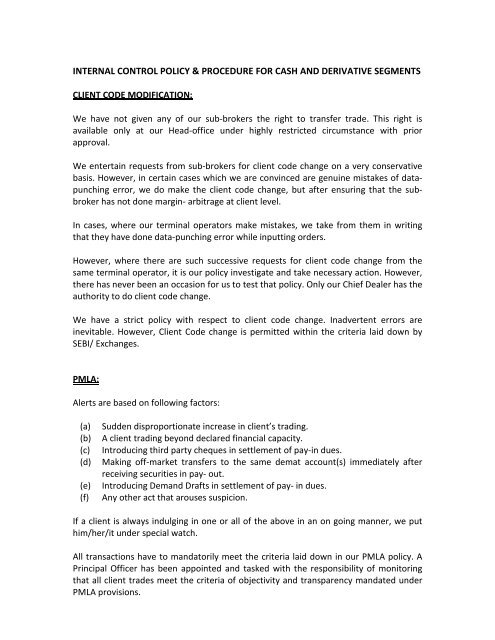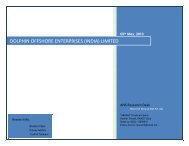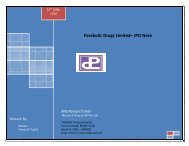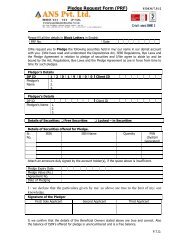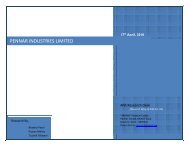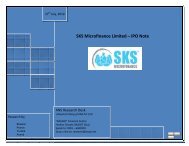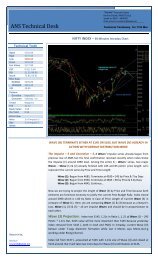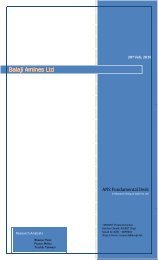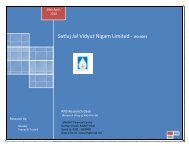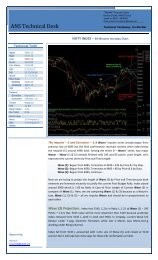haircut
INTERNAL CONTROL POLICY
INTERNAL CONTROL POLICY
- No tags were found...
You also want an ePaper? Increase the reach of your titles
YUMPU automatically turns print PDFs into web optimized ePapers that Google loves.
Clients are given the cheques for their dues on the very day the pay-out is received fromthe Stock Exchange. However, clients maintaining their account on a running basis donot take their pay-out on a transaction-to – transaction basis. Whenever they want thepay-out, they inform us through sub-broker (or a direct client will inform the AccountsDepartment in Corporate Office) and the credit balance (which has become due – acredit balance for which the exchange pay-out is not received is considered not due) isreleased to the client. In case of dividend receipts on client securities, our back-officesystem is so designed as to discern the specific clients for whom the dividends arereceived. The client-dividends received by us are credited to respective client accounts.All client securities are strictly received from the client beneficiary accounts mappedwith us. It is our policy not to accept transfer of securities from beneficiary owneraccounts which are not mapped with us. In case of transfers from undiscerned (orunmapped) beneficiary accounts, we do return the securities to the same beneficiaryowner accounts from which the securities are received. This is done to keep an audittrail of securities received by us from clients towards their pay-in and marginobligations. We do maintain a single and consolidated Beneficiary Owner Account toreceive all client securities. However, we have a facility in our back-office to trace thesecurities in the single consolidated beneficiary account to respective clients. All clientsecurities are strictly used to meet client pay-in and margin obligations. Similarly, clientsecurities pay-outs are given to the client beneficiary accounts which are mapped withus. It is our policy not to make client securities pay-outs to third-party accounts.BOLT / IML Terminal:It is our policy not to give direct exchange terminals to our sub-brokers. However, to ourbranches we do give direct terminals. Such direct terminals are operated under thestrict supervision of senior staff. To, our sub-broker, we only allocate IML/ CTCLterminals, so that the Risk Management is online and dynamic. A sub-broker is given atrading limit based on his total deposit (both in terms of cash and securities) with us.The simple criterion is that the total loss, if any, on the various orders under the subbrokers’IML/ CTCL terminal should not exceed the sub-broker deposit with us. In caseof any order value or loss exceeding the sub-broker deposit, the sub-broker is asked toreplenish his deposit.Contract Notes:All contract notes are generated in the specified formats from the software. Thecontract generation is centralized and takes place only at our corporate office. Ourpolicy is to mail the Contract Notes to client e-mail id, as given by him/ her, in the KYC.No contract is physically sent to the clients. It is mandatory for clients to provide their e-mail for Contract Notes. In case the client desires to receive the Contract Note inphysical form, he/ she is levied a charge of Rs. 40/- per Contract Note. This is mentionedin the tariff sheet in KYC. We preserve and maintain logs of electronically transmittedContract Notes. We also maintain and preserve Proof of Delivery of Contract Notes sentin physical form. In case of any electronic mail of Contract Note bouncing, we do send itto the client in physical form and preserve its Proof of Delivery. However, as provided inKYC, we do charge the client an amount of Rs. 40/-
Statements of Accounts:Statements of Accounts are dispatched to clients on monthly/ quarterly basis as optedby the client in KYC, by way of e-mail to the client e-mail provided by the client in KYC.The log of the e-mail is preserved as proof of dispatch. In case of e-mail bouncing theStatement of Account is physically sent to the clients and a charge of Rs. 40/- is leviedon the client. In case of physical dispatch, the proof of delivery is maintained by us.Execution of Power of Attorney (POA):It is our policy to get the clients to execute a POA in our favor to enable us to debit clientbeneficiary accounts for client pay-in and margin obligations. The POA confers on us theauthority to debit the client beneficiary accounts only to the extent required for clientpay-in and margin. We do maintain a register of POAs executed by clients in our favor.Where clients have not executed POA, they are required to transfer securities to ourbeneficiary account through a physical trade, which can involve delay or even omissionon the part of client to transfer such securities for pay-in and margin. This may entailauction loss to the client. It is therefore in client interest to execute POA for pay-in/margin obligations, which we convey to the clients when they approach us for openingaccounts.Receiving and Execution of Orders:Orders may either be executed from our terminals or sub-broker allotted terminals. Allsub-broker client orders are executed from sub-broker terminals. In case of ordersexecuted from sub-broker terminals, it is the responsibility of the sub-broker to ensuresanctity of the order. In case of any sub-broker client disputing or abdicating any orderexecuted in his/ her account, the impact of such order has to be borne by the subbroker.However, in case of orders being executed from our end, our dealers usuallyhave voice-recognition of the clients calling them or in case of doubt the dealers verifythe veracity of client by cross-checking the client’s personal details. In case of internetbasedorders, all orders executed from the client’s internet-based trading terminal haveto be necessarily born by the client. The clients are not allowed to place orders at priceswhich are out of sync with the current market price of shares, in order to ensure thatclients do not disrupt the market integrity and also there are no large cumulativeunexecuted orders in the trading terminals.Portfolio Manager:As and when we because a Portfolio Manager, we shall evolve an elaborate set ofpolicies in keeping with SEBI regulations for servicing portfolio clients.Brokerage Charged:It is defined in tariff sheet of KYC.
Client Margin Intimation:Client Margin intimation is sent to the clients along with Contract Note. Any shortfall ordeficit of margin is supposed to be replenished by clients before the start of next tradingday. Client exposure is equivalent to the client margin deposit (both in cash andsecurities). The client’s ledger credit is also counted by us as client margin. Since clientmargin intimation is sent to clients along with Contract Notes, the log of Contract Noteis automatically the log of client margin intimation. In case of mail bouncing, it isphysically sent and its Proof of Delivery is maintained. The policy enunciated forContract Notes for dispatch also applies to Client Margin Intimation.KRA Procedure & PolicyWhen the filled KYC along with the requisite documents is received, it is checked foraccuracy of entries and documents attached therewith as proof of identity, address,bank account and demat account. Once they are found in order, the requisite data arefed into our back office software which generates the client code. If the KYC alsocontains the account opening form for demat account, the requisite data are uploadedto CDAS, which then generates a response file which contains the beneficiary accountnumber. The response file of CDAS is uploaded in the back office system which thenimports in the demat account number generated by CDAS. The demat account detailsare then updated in the software which contains the data inputs of trading account.Thereafter the unique client code is uploaded in NSE and BSE, with all the requisitedetails.Thereafter the KYC and supporting documents are sent to scanning department, whichscans the KYC and supporting documents. After scanning of documents, Annexure I, PANCard Copy and address Proof are separated from the rest of KYC. From Annexure I andPAN Card Copy and address Proof, the requisite data is entered into the data of the KRA.At this KRA generates a unique KRA number, which is written down on top of everyAnnexure I. This process being over, Annexure I with all the supporting documents areuploaded to KRA. On a periodic basis, we check the KRA system to ascertain if any of ourclient accounts uploaded into KRA database are put under ‘Hold’ for want of anyrequisite information. If there is any such client account under Hold, the missinginformation along with supporting documents are uploaded to KRA, The KRA, then,removes the account(s) from Hold status.Policy for unauthentic news circulation:None other than our Senior Research Analyst is allowed to pass on any market relatednews and developments. This way we keep a tab on spread of rumours andunsubstantiated news items among our clients and associates – Even as our seniorResearch Analyst disseminates any news item with a brief analysis of its impact, theinvestors are any-way cautioned that they must exercise their best judgment whileacting on any news propagated by our Research term
Policy to safeguard against insider trading:The trading room is provided with a camera and microphone and the activities in thetrading room are recorded and kept under constant surveillance. Employees are notallowed to trade in the normal course. Employees are allowed to buy and sell sharespurely from an investment point of view and any employee wanting to buy and sell hasto take prior permission of the management. All employee accounts are under zerolimit. However, an employee being allowed to buy and sell, he/ she is allowed amaximum limit of Rs. 50, 000/- This does not however mean that an employee would beallowed to utilize this limit on a daily basis. No employee is allowed to trade on acontinuous basis for two days. Dealers are continuously watched to make sure that nodealer is leaking client information. Any employee found leaking client information issubject to immediate dismissal.


